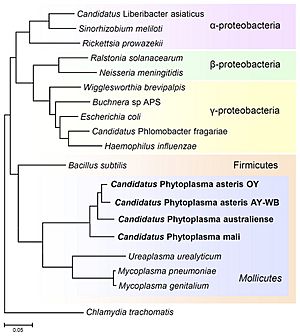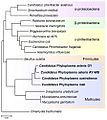Mollicutes facts for kids
Quick facts for kids Mollicutes |
|
|---|---|
 |
|
| Acholeplasma palmae | |
| Scientific classification | |
| Kingdom: | |
| Phylum: |
Firmicutes or
Tenericutes |
| Class: |
Mollicutes
Edward and Freundt 1967 |
The Mollicutes are a special group of bacteria. What makes them unique is that they don't have a cell wall. Most other bacteria have a strong cell wall. The most famous type of Mollicutes is called Mycoplasma.
These tiny bacteria are super small, only about 0.2 to 0.3 micrometers in size. That's smaller than most other bacteria! They also have a very small genome, which is like their instruction book. Most Mollicutes move by gliding slowly across the surfaces of cells. But one type, called Spiroplasma, is shaped like a helix (a spiral) and moves by twisting its body.
Contents
What are Mollicutes?
Mollicutes are parasites. This means they live on or inside other living things, called hosts. They get their food and shelter from these hosts. They can infect many different animals and plants. Many types of Mollicutes can cause diseases in humans.
Mollicutes and Human Health
Some Mollicutes, like Mycoplasma and Ureaplasma, can stick to cells in the lungs. They can also attach to cells in tubes like the urethra. When they do this, they can cause infections and make people sick.
Mollicutes and Plants
Other types of Mollicutes, such as Phytoplasma and Spiroplasma, are pathogens for plants. This means they cause diseases in plants. They often use insects as vectors. Vectors are like tiny delivery services that carry the bacteria from one plant to another. For example, bugs called leaf-hoppers (which are a type of Homoptera) can be vectors. They use their mouth-parts to poke into a plant and suck its sap. While they are feeding, they can deliver the Mollicutes into the plant, spreading the disease.
Images for kids
See also
 In Spanish: Mollicutes para niños
In Spanish: Mollicutes para niños


